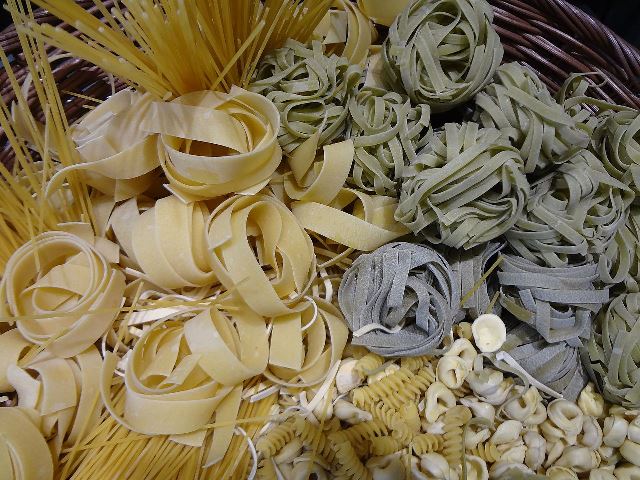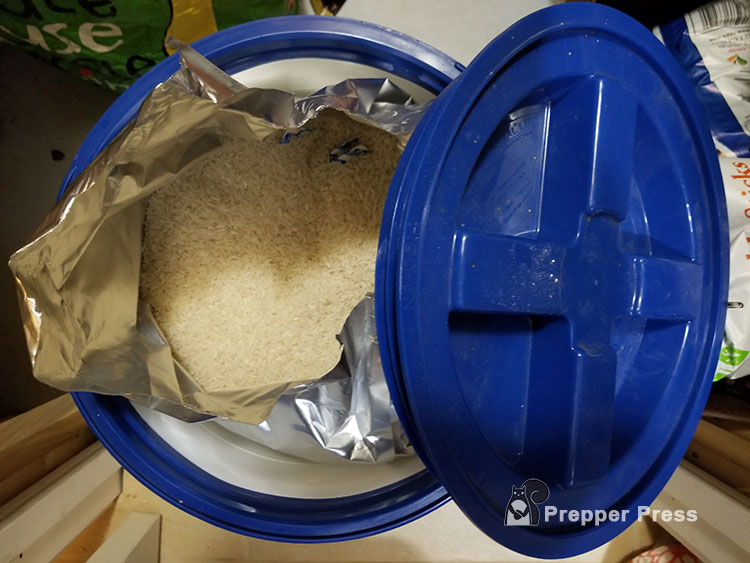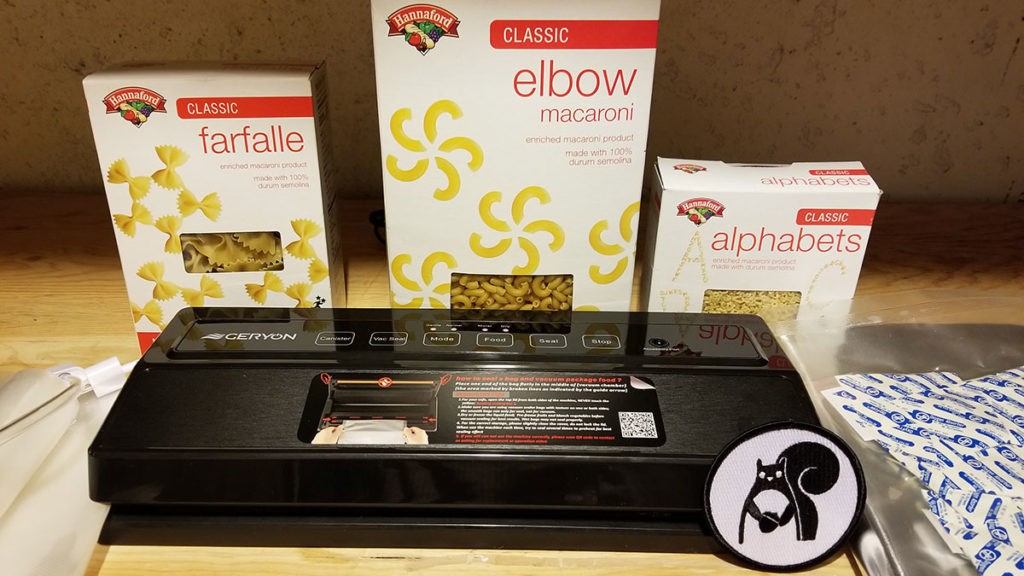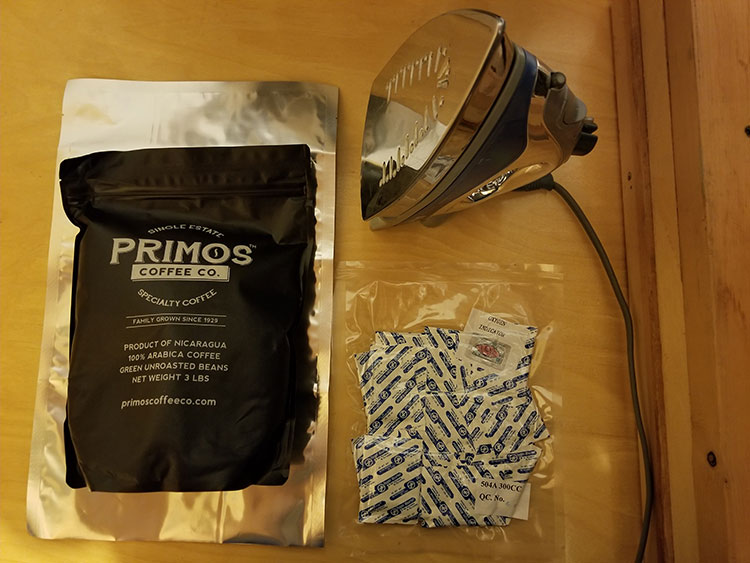
Pasta is a staple in most preppers’ pantry supplies. Long-term pasta storage might seem easy to most, and while it is listed as one of the best foods for long-term storage, there are still some factors to consider. Let me back up for a moment…
I got a call from my girlfriend asking me what the shelf life of dried pasta is. When I asked why she wanted to know, she said she was trying to fix dinner and about the only thing they had in the pantry was a single box of, believe it or not, HBO pasta with “Sopranos” shapes.
She said she had never seen it before. The box was unopened and COVERED with dust, the use by date was seven years prior (if I remember correctly)! Aside from the fact that I needed to take her to the grocery store and fill the cabinets, I also got to realizing that many people have no concept of what is an OK amount of time for long-term pasta storage.
Thus, here we are. I am going to cover not only how to store pasta for a long time but also how to determine when pasta has gone bad. Pasta is a great addition to your food storage. It will break up the monotony of freeze-dried foods and everyone loves a warm bowl of spaghetti.
Long-Term Pasta Storage Instructions
First off let’s discuss storage. The ideal conditions for long-term pasta storage include:
- A dry location with little or no exposure to humidity.
- A dark location, such as in a pantry or cabinet.
- A cool location. Room temperature is OK. Avoid a pantry that is near your water-heater or indoor A/C unit (air-handler).
- Pest-free containers (i.e. insects, rodents, etc.) away from your foodstuffs as much as possible. While it is true you can never be 100% free of pests, take simple precautions to avoid pests. Don’t leave exposed foods out. Inspect for presence of pests (i.e. scat, damage to containers/walls/doors, trails, etc.). If you find signs of them, use traps before you resort to chemical warfare!
From this list we can extrapolate 4 main enemies of long-term pasta storage: light, heat, moisture, and pests. Let’s take these on one by one.
#1 – Avoid Light Exposure
Light, a co-conspirator with heat and moisture that can lead to bacteria buildup and ideal conditions for pests to thrive, is also a threat on its own. When your pasta is exposed to a source of light for extended periods — as little as a couple of days — the pasta’s natural riboflavin can become degraded. Riboflavin, also known as vitamin B2, is essential in the body’s breaking down carbohydrates, proteins, and fats to produce energy. It’s also instrumental in the efficient use of oxygen in the breathing cycle. The best way to preserve the riboflavin in your pasta is to store it away from light. Don’t worry — it won’t get lonely.
#2 – Avoid Humidity
Pasta likes to be dry until cooked. The effects of moisture on uncooked pasta can destroy its value as a reliable food source from your pantry. Unintended moisture can encourage the growth of bacteria and mold, as well as degrading the flavor and nutritional content of your noodles. Now, we trust that you wouldn’t store your pasta in a puddle of water at the back of a shelf that’s being leaked on, but moisture comes from more sources than liquid water. It can come in the form of moist air — that is, simply an atmosphere with a high humidity content.
That’s one reason why you should store your pasta in an airtight container. If no air can reach the inside of the bag, box, or bucket, then the air can’t carry undue moisture onto the surfaces of your pasta. So whether you buy an airtight plastic storage bin, or bag your pasta oxygen-free with a vacuum sealer and desiccants, the dryer you can keep it, the better. Pasta can have a shelf life of many years, when stored properly. Just think, a couple years into a SHTF situation, you’ll be dining on fettuccini alfredo while your neighbors down the road are clutching at dandelion greens in a desperate bid at nutrition.
#3 – Avoid Heat
If you’ve ever worked in foodservice for a reasonable amount of time, chances are you had to go to a seminar and get your ServSafe certification, which includes learning about the “Temperature Danger Zone,” or TDZ. Simply put, it represents an awareness that between 41 and 135 degrees Fahrenheit, food stored at this temperature is ripe for the picking when it comes to bacterial growth and contamination. But between 70 and 125 degrees, it’s an open invitation.
Yes, usually the TDZ refers to hot food that’s now being stored for future service, but it also covers uncooked food. If you store your pasta in too warm of an environment, not only can bacteria build up, but pests like weevils can find a delicious source to nibble on: your dry pasta.
#4 – Avoid Food Pests
That brings us to insects and other creatures that want to feed on the very same pasta that you’re hoping will have a shelf life of decades. Mice and rats can chew through conventional packaging and they have no conscience when it comes to stealing someone else’s food. Insects are even worse, and worms, well, there’s nothing so unappetizing as that. The shrewd prepper, therefore — and we know you are one — will utilize methods of pasta storage that will thwart the best efforts of pests helping themselves to your food.

Make it airtight, yes, but also tooth-proof. Go the extra mile and place the bags within a food-grade 5-gallon bucket, with the lid firmly sealed. This will eliminate the possibility of pest infestation, and it will extend your pasta’s storage life exponentially. In the battle of man versus beast, make sure it’s you who wins.
Ways to Store Pasta for Long-Term Storage
Want to take your long-term pasta storage to a whole new level!? You can eliminate any chance of air getting to your pasta buy using one of two methods: vacuum sealing and Mylar bags.
Vacuum Sealing Your Pasta
You can use something like the GERYON Vacuum Sealer to remove air and extend pasta shelf life in a gigantic way. This is an exceptionally easy method.

Most vacuum sealers will come with clear plastic bags for sealing everything up. These needs to be stored away from light, however. It is unlike Mylar bags, which both seals out air and light.
Mylar Bags and Food Grade Buckets
Preppers know this approach to long-term food storage. It’s simple and effective. This low-cost strategy requires a few items:
- Mylar bags
- O2 absorbers
- Clothes iron
- Pasta
You put the pasta in your Mylar bag and leave enough room to seal the end closed. Toss some O2 absorbers in (how many O2 absorbers to use), push the air out as best as you can, and heat seal it with your clothes iron (on maximum setting). After 24 hours, the O2 absorbers will suck up whatever air was left, leaving your pasta ready for serious storage.

How to Tell if Pasta has Gone Bad
The big things to look for when you think pasta or rice are no longer good are discoloration, unusual texture, and an “off” smell. The latter of which is the least likely to occur, because it’s a dry product. The best way to determine if pasta or rice is still good is the color/texture.
Like many dried foodstuffs that are low in protein and fat, the shelf life of pasta increases dramatically when stored properly. While there is usually a “use by” date on the package, pasta and rice will keep in ideal conditions almost indefinitely. We are talking the possibility of YEARS beyond what the manufacturer recommends!
If the pasta usually has a pale yellow color, but your older stuff has white marks forming on the surface, chances are it’s time to get rid of the stuff you have and replace it. This would serve as an example of unsuccessful long-term pasta storage. If the pasta usually has a very hard texture and is in tight little strands (spaghetti) that look like sticks, but yours seems to be crumbling at the edges, it’s time to re-supply!
Rotating Your Stock of Pasta
The single best thing you can do to ensure your dried complex carbohydrates are fresh and tasty, is to rotate them periodically. Honestly, this is probably the biggest challenge for me. I always seem to have my ADD kick-in when I am about to write the product/date on my storage chart… sorry, there was something shiny on the other side of the room that caught my attention!
But if you’re conscientious and keep on top of how long you’ve been storing which foodstuffs, you’ll have a supply of pasta going ahead years and years. You’ve considered temperature, humidity, and exposure to light, and you’ve conquered all the little beasties that want to “share” your food supply, and you’ve come out on top. Bon Appetit!

8 comments
First off, I’d like to suggest that SHTF Blog consider having ChefBear do a weekly article about food prepping and a featured recipe, maybe geared towards the minimalist bend. Like this post, the information he provides is excellent, pertinent & he laces in an appealing sense of energy, keeping a view of life on the half full side.
As the stresses of the current times continue pressing down on all of us, exposing the failures of a life of excess – which hits every economic strata, I believe it is important to grab life for what it is not what Charlie Sheen deems as fair & reasonable! Excuse me while I step outside to puke.
My attraction to survivalist blogs is to learn exactly that – how to make do with less & eventually become completely self-sufficient, to me, the ultimate engineering feat. Whatever happens in the world becomes nearly irrelevant once you achieve the ability to self support with the essentials of life. (Does that help you Jarhead?)
For many years I associated with friends who lived through the Depression & would spend hours with talking about how to make something from what was simply laying around. A very good friend, Joe Corey, taught me how to tie all kinds of knots in ropes that were easily undone, make a mulch pit – he could literally throw a tomato down on the mulch dirt, do nothing but very little water & grow incredible tomatoes. He made tools, made things last, created very little trash and at the ripe old age of 77 (1995) he built our 10 yard concrete slab – that’s one full truck load, barely breaking a sweat plus, he graded the dirt & bent & tied all of the rebar steel prior to.
Similar to the incorporated Clara YouTube, that information & mindset is invaluable & a lost art.
Chef – great fishing tip, my 18 year old son will love it. He got me hooked (pardon the pun) on fishing & hunting when he was 9 as I was looking for a break from the concrete jungle and he had been reading – on his own, about hunting, fishing & survivalism … strange kid, ha-ha.
Question for you:
Can you handle your ADD without pharmaceuticals?
I am 56, grew up with a learning disability – ADHD, which accounted for some of the hell & torture in my life. They had no idea what it was back then. I was a gifted athlete (given a scholarship at 15 years old to major university after I graduated high school), very strong mathematically but barely passed the easy subjects & I mean barely.
I was diagnosed with ADD 5 years ago and my life completely changed and began to make sense for once. They tried all of the usual assortment of drugs but I could not tolerate the altered state. One of the doctors I saw gave me a few books and exercises to try and they worked. By the way, both doctors (experts with ADD) said you grow out of the H part as you age, still trying to figure when that age applies!
BTW Chef – Heart attack casserole is a gross understatement! Why is it that everything that tastes so damn good has to be so bad for you or at least me?
Thank you Jason.
I got started in fishing/hunting, because I would spend summers with my Grandfather and Uncle while my dad was on TDY all over the world. My grandfather is the one who really got me addicted to fishing, he started me with salt-water, and even used to take me freshwater fishing in the Florida everglades, and I have been fishing EVERY chance I get since then!
I was originally diagnosed with ADHD, which has developed into ADD over the years. I have found that it actually has some benefits in a professional kitchen… For example it actually makes it easier for me to multi-tast, which I assume is because I am used to having my attention divided in several different directions.
I haven’t taken medications to regulate my symptoms since I was about 12 years old. I have found that a heavy exercise program helps, it will help develop better focus and burn off excess energy/stress. Regular reading seems to help to, by sitting with little/no distractions and trying to direct all of my attention/focus on reading, it helps me to block out things which helps in everyday life. I have noticed that taking a multi-vitamin, and eating a lean protein and “good” carbohydrate diet has been beneficial as well. I stopped taking the medications the doctors gave me because I couldn’t/didn’t want to deal with the side effects. For me, most of them made me a lot more aggressive or made me feel like my heart was going to beat out of my chest!
Good job Chef! What about egg noodles and potato flakes?
The good news is that the storage for both of these items is the same as what I mentioned in the article. The egg noodles will show similar signs to the pasta when it is “past it’s prime”. The potao flakes are harder to tell, because they are cooked, dried and smashed potatoes, you really will have to cook up a sample batch to be sure there are no weird flavors/smells. The good news is that the potato flakes will last just about forever, if stored properly.
Hey PND,
How about potato noodles with corn flakes?
Thanks again, great info.
You’re welcome, thanks for reading!
I have come elbow macroni that has been stored 5 years. Glass jars. Oxygen absorbers. Stored in indoor garage. Jars sealed in 2015. Went to get some today and some of the noodles are brown. Some are not. Are the brown bad? (I cooked some up and they taste ok – just look funky.) Can I pick out the brown noodles and still use the yellow macroni?